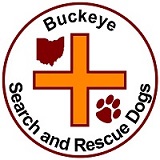
As mentioned on the “Scent” page, every person has a unique scent. Likewise, the decomposition process releases its own distinctive scent in the form of particles, gases and fluids. This scent is buoyant, floating to the top of water in which the human remains are submerged. There the scent is carried by the current (even lakes and ponds have currents), as well as the air currents near the surface of the water.
The Water Human Remains Detection (W-HRD) K9/handler team takes advantage of this fact to find the scent floating on the surface of the water and follow it to the strongest source, which will be the point in which the scent is “breaking the surface.” This point will be near (but not necessarily directly over) the location of the human remains.
The objective of a K9-based water search is not necessarily to find the exact location of a submerged body, but instead to…
- quickly determine whether a body of water is likely to contain submerged human remains and if so…
- identify the smallest possible area around the remains so that the sonar and dive teams can home in more easily.
Working the Shoreline
Assuming there are no witnesses or other evidence to specifically point to a drowning, a K9 W-HRD team can often see if a water search needs to be prioritized as part of the overall Missing Person Incident. One or more K9 teams can work as close to the water as they can from the shore. Searching around a lake or pond, or on opposite banks of a stream or river, the handlers will watch the dogs for any indications that they are detecting human decomposition scent from the direction of the water. If so, that area is marked and reported back to the Incident Command Post (ICP) as a clue to potentially influence the next stage of the search.
Working from a Boat
If a suitable boat is available and the Incident Commander (IC) authorizes a boat search, the K9 W-HRD team can use the boat to extend their search patterns onto the surface of the water. This is most useful on bodies of water that are too large to be easily searched from the shore, or to further define an area where sonar and/or divers can focus their effort.
The boat team will typically consist of the K9, the handler, and a boat driver. Depending on the size of the boat, it may also include a flanker/spotter to assist with GPS marking and communications. Very large boats, like those used on a major river or lake, may also have additional personnel.
As in an Area Search or a Land HRD Search, the K9 handler will decide upon a strategy to locate the scent cone. Every handler has their preferred method, which can include techniques like working a grid, working in from the perimeter, segmenting the area into smaller pieces, or quartering across the wind. They will adapt the strategy based upon the terrain conditions and the weather at the time of the search. If there is little air movement, they may attempt to work a grid in order to locate a scent pool.
The handler will watch the K9 for body language indications that the dog is picking up scent and will give direction to the boat driver as to where to move with the aim of finding the spot where the K9 will give his Trained Final Response.
Sonar
Many dive teams will not go into the water without first identifying an object to investigate via a sonar or underwater camera image. This is not intended to be a slap at the K9’s abilities, but is a safety issue. Recovery diving, as this is known, is dangerous work. The water is often cold (even on hot days), dark and murky, and there are almost always currents pulling at the divers. There are underwater hazards like trash, sharp rocks, and things like trees in which to get entangled. And the divers are almost always searching for a submerged human body by feeling for it.
If the sonar team identifies a likely object to be investigated by the divers, the team will mark the location and communicate it back to Dive Captain, who will ultimately relay the info up the chain of command to the ICP. They may also drop an anchored dive target as close to the object as they can. This target is used as a reference point for the divers to use.
Diving
The Dive Captain is ultimately responsible for the safety of the dive team. Once the W-HRD K9 team has identified an area and the Sonar Team has identified one or more objects to investigate, the Dive Team will deploy to search the area around the dive target. If the object turns out to be the missing person, the divers will notify the Dive Captain and the recovery process will begin. If the target is something else, the divers will either move to the next dive target, or move back and stand by as the search continues.
The cycle of K9s, sonar, and dives will continue until the missing person is located and recovered or the search is suspended until further investigation can provide additional clues with which to work .
